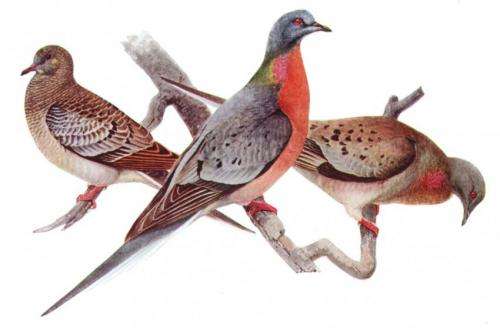June 17, 2014 report
Huge population fluctuations could have preceded passenger pigeon extinction

(Phys.org) —In the 19th century, billions of passenger pigeons crowded the skies of North America. By 1914, the birds had become extinct. Previously, ecologists thought human activity was responsible for the passenger pigeon's sudden, rapid demise. Now, Shou-Hsien Li of National Taiwan Normal University and colleagues have found that changes in environmental conditions may have caused passenger pigeon populations to fluctuate dramatically. A natural decline in population, combined with human activity, may have resulted in extinction. The research appears in the Proceedings of the National Academy of Sciences.
In the 1800s, observers reported flocks of passenger pigeons blanketing the sky. James Audubon, the artist and ornithologist, once described a flock of passenger pigeons blocking the sun for three consecutive days. Population estimates for the beginning and middle of the 19th century ranged from three to five billion.
Within a human lifespan, the species was extinct. What caused the birds to disappear so suddenly? Previous researchers blamed human hunting and deforestation. However, Li and his team thought changes in the environment, independent of human activity, could have caused the population to fluctuate.
To determine past population sizes, the researchers mapped the passenger pigeon genome, using DNA from three museum specimens collected across the birds' feeding range, and compared it with the genome of the modern domestic pigeon. They found that the passenger pigeon's effective population size, the number of individuals needed to produce the amount of genetic variation found in the species, was only about 330,000. This showed the population had not always been in the billions. Instead, it fluctuated, rising rapidly during population outbreaks and then declining again.
When the researchers reconstructed the birds' genetic history, they found that population changes corresponded with the Earth's climate history. The population shrunk during the last Ice Age and rebounded after the glaciers retreated.
The team also looked at the availability of acorns, the birds' main food, over the past 21,000 years. A study of fossil pollen records showed that oak cover has been decreasing since about 9,000 years ago. The decline in oak cover would have caused a corresponding decline in the pigeon population.
Li's team think European immigrants to North America could have reversed the downward trend temporarily, causing the population surge that resulted in flocks of passenger pigeons blotting out the sun. Agricultural crops would have provided the birds with more food, compensating for the loss of oak cover. By driving out Native Americans, the Europeans could have contributed to the pigeon population explosion; Native Americans were active passenger pigeon hunters.
Ther researchers believe that by the late 1800s, the downward trend had reasserted itself. This, combined with human exploitation, resulted in rapid extinction.
More information: Drastic population fluctuations explain the rapid extinction of the passenger pigeon, Chih-Ming Hung, PNAS, DOI: 10.1073/pnas.1401526111
Abstract
To assess the role of human disturbances in species' extinction requires an understanding of the species population history before human impact. The passenger pigeon was once the most abundant bird in the world, with a population size estimated at 3–5 billion in the 1800s; its abrupt extinction in 1914 raises the question of how such an abundant bird could have been driven to extinction in mere decades. Although human exploitation is often blamed, the role of natural population dynamics in the passenger pigeon's extinction remains unexplored. Applying high-throughput sequencing technologies to obtain sequences from most of the genome, we calculated that the passenger pigeon's effective population size throughout the last million years was persistently about 1/10,000 of the 1800's estimated number of individuals, a ratio 1,000-times lower than typically found. This result suggests that the passenger pigeon was not always super abundant but experienced dramatic population fluctuations, resembling those of an "outbreak" species. Ecological niche models supported inference of drastic changes in the extent of its breeding range over the last glacial–interglacial cycle. An estimate of acorn-based carrying capacity during the past 21,000 y showed great year-to-year variations. Based on our results, we hypothesize that ecological conditions that dramatically reduced population size under natural conditions could have interacted with human exploitation in causing the passenger pigeon's rapid demise. Our study illustrates that even species as abundant as the passenger pigeon can be vulnerable to human threats if they are subject to dramatic population fluctuations, and provides a new perspective on the greatest human-caused extinction in recorded history.
Journal information: Proceedings of the National Academy of Sciences
© 2014 Phys.org



















